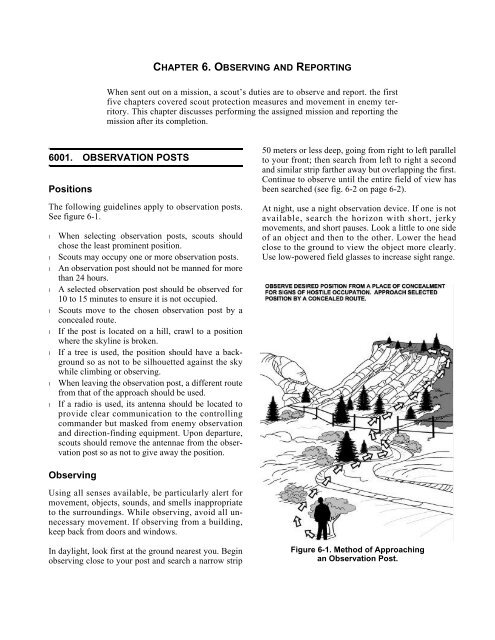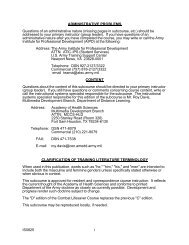MCWP-3-11.3-Scouting-and-Patrolling
MCWP-3-11.3-Scouting-and-Patrolling
MCWP-3-11.3-Scouting-and-Patrolling
Create successful ePaper yourself
Turn your PDF publications into a flip-book with our unique Google optimized e-Paper software.
CHAPTER 6. OBSERVING AND REPORTINGWhen sent out on a mission, a scout’s duties are to observe <strong>and</strong> report. the firstfive chapters covered scout protection measures <strong>and</strong> movement in enemy territory.This chapter discusses performing the assigned mission <strong>and</strong> reporting themission after its completion.6001. OBSERVATION POSTSPositionsThe following guidelines apply to observation posts.See figure 6-1.l When selecting observation posts, scouts shouldchose the least prominent position.l Scouts may occupy one or more observation posts.l An observation post should not be manned for morethan 24 hours.l A selected observation post should be observed for10 to 15 minutes to ensure it is not occupied.l Scouts move to the chosen observation post by aconcealed route.l If the post is located on a hill, crawl to a positionwhere the skyline is broken.l If a tree is used, the position should have a backgroundso as not to be silhouetted against the skywhile climbing or observing.l When leaving the observation post, a different routefrom that of the approach should be used.l If a radio is used, its antenna should be located toprovide clear communication to the controllingcomm<strong>and</strong>er but masked from enemy observation<strong>and</strong> direction-finding equipment. Upon departure,scouts should remove the antennae from the observationpost so as not to give away the position.50 meters or less deep, going from right to left parallelto your front; then search from left to right a second<strong>and</strong> similar strip farther away but overlapping the first.Continue to observe until the entire field of view hasbeen searched (see fig. 6-2 on page 6-2).At night, use a night observation device. If one is notavailable, search the horizon with short, jerkymovements, <strong>and</strong> short pauses. Look a little to one sideof an object <strong>and</strong> then to the other. Lower the headclose to the ground to view the object more clearly.Use low-powered field glasses to increase sight range.ObservingUsing all senses available, be particularly alert formovement, objects, sounds, <strong>and</strong> smells inappropriateto the surroundings. While observing, avoid all unnecessarymovement. If observing from a building,keep back from doors <strong>and</strong> windows.In daylight, look first at the ground nearest you. Beginobserving close to your post <strong>and</strong> search a narrow stripFigure 6-1. Method of Approachingan Observation Post.



